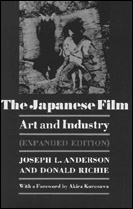The Japanese Film: Art and Industry

- Author
- Donald Richie, Joseph L. Anderson
- Publisher
- Princeton University Press
- Published
- 16 February 2004
by Jasper Sharp
Long considered the definitive text on Japanese cinema and only recently supplanted by Donald Richie's A Hundred Years of Japanese Film, The Japanese Film: Art and Industry was co-written in 1959 by Richie and Joseph L. Anderson. The book was re-issued in 1982 in an expanded edition to take in the subsequent 20 years. The focus is more on the early developments, covering in considerable detail the industry's historic origins and the birth of the major companies, Nikkatsu, Shochiku, Daiei, and Toho, the work of early pioneers such as Daisuke Ito (with films such as the superbly titled Man-Slashing, Horse-Piercing Sword in 1930) and Teinosuke Kinugasa (the Eisenstein-influenced expressionism of A Page of Madness in 1928), and how the lie of the land was influenced by the likes of Ozu, Kinoshita and Kurosawa.
This historic perspective is what elevates the book above all the others on review here. Subjects such as early developments in Japanese silent film may not sound particularly inspiring, but there's some revelatory material here, especially on the role of the benshi, the narrators of early silent films whose running voice-over commentary was considered an integral part of the cinema experience and whose status in the early days outstripped that of the actual actors appearing in the films. With their existence threatened by the coming of talkies, the powerful influence of these major players as they unionised and went on strike to protect their interests hindered the coming of the sound era by several years (the first successful talkie being Heinosuke Gosho's The Neighbour's Wife and Mine in 1931, though this new type of film didn't really get underway properly until several years later).
There are plenty of other fascinating insights too, including how wartime propaganda films were nurtured under the Office of Public Information, whose monopoly of raw film stock as a "war material" meant that the studios were forced to make the type of films the State demanded; the birth of the documentary by way of the wartime newsreel; Japan's influence on cinema in its occupied territories such as Manchuria, Burma and Taiwan; the subsequent blacklisting of a number of prominent industry figures accused of war crimes; the censorship of film scripts by the Occupying forces, and the sensation of Japan's first onscreen kiss in Yasushi Yasaki's Twenty-Year-Old Youth in 1946 (all kisses had previously been cut from imported foreign films).
Anderson and Richie's book is an invaluable resource, covering a whole host of seminal works that have either been forgotten or lost all the way up to the New Wave and beyond. However, for a book that claims to cover the main significant developments of the industry, some readers might question the absence of the likes of Seijun Suzuki, Kinji Fukasaku and Nikkatsu's Roman Porno films from these pages, as well as Godzilla's relegation to a mere passing mention. Perhaps such omissions are best explained away in terms of when the book was originally written rather than any inherent snobbery on the behalf of the authors.